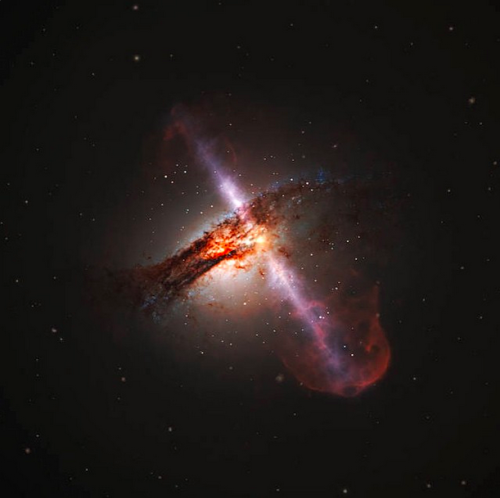631 Exposures Blended - Cloverdale, CA

631 Exposures Blended - Cloverdale, CA
js
More Posts from Andromedasbitch-blog and Others

The two high-speed jets of plasma move almost at the speed of light and stream out in opposite directions at right angles to the disc of matter surrounding the black hole, extending thousands of light-years into space. NASA

Hand of God
js

“I liked them before they were famous”




Stellar Evolution: How Stars Die
Depending on their mass, stars follow one of three evolutionary routes. When they end their lives they may become white dwarves, neutron stars, or black holes.
All stars fuse hydrogen into helium at their core, releasing energy that balances the force of gravity that pulls inwards. Helium is denser than hydrogen, so as it is created, it makes the star’s core hotter and more pressurised. Eventually, the temperature is high enough to fuse the hydrogen around the core, and as fusion reactions happen faster and faster, the force released pushes away the outer layers of the star. Since the star’s radius increases, its energy radiates away over a larger surface area and it emits cooler red light. The star is now a red giant. When it reaches temperatures of 100 million Kelvin and begins to fuse helium into carbon and oxygen, it may take three paths depending on its initial mass.
In light stars like our sun, all their fuel will have run out before temperatures get hot enough to fuse carbon and oxygen into heavier elements. All the excess gas and dust is blown off by stellar wind, forming a planetary nebula, and eventually the star simply becomes a hot, dense carbon and oxygen core: a white dwarf. To take this evolutionary route, a star must be less than 1.4 times the mass of our own Sun, otherwise known as the “Chandrasekhar Limit”. When a star stops producing energy, the only thing stopping gravity from collapsing the star is electron degeneracy pressure: when electrons are squeezed together, they repel each other, thus resisting gravitational collapse.
A star more massive than the Chandrasekhar Limit will collapse even further. As a red giant, its temperatures will become high enough to fuse oxygen and carbon into heavier elements. Fusion continues on and on until iron is created—and since fusing iron uses up energy instead of creating it, fusion stops. Electron degeneracy pressure is the only thing stopping the star from collapsing, and then that gives in too. Electrons are squeezed into the nucleus of the atom, protons turn into neutrons, and the core of the star is soon just a super dense ball of neutrons. An enormous amount of energy is released in the collapse—material hurtles down towards the core and bounces off, creating an immense shockwave that blasts away the rest of the star in a supernova. It’s so bright and energetic that it can temporarily outshine an entire galaxy, and can fuse even heavier elements, like uranium and gold. After the explosion, all that’s left is a neutron star: a stellar corpse 1.5 to 3 times the mass of the sun, but compressed to the size of a city in Earth (30 km in diameter).
But if the original star is more than 20 times the mass of our sun, something even wackier will form at the end of its life: a black hole. It goes from red giant to supernova to neutron star—but it doesn’t stop collapsing. Instead of forming a ball of neutrons, the star’s mass is so great that it collapses down and down to a point so small it must have infinite density. This is called a singularity. To quote Sir Roger Penrose, ‘Thou shalt not have naked singularities’, meaning that they cannot exist with an accompanying event horizon. Anything that crosses beyond this horizon can’t escape the immense gravitational pull of the singularity, not even light. Together, a singularity and its event horizon form a stellar mass black hole.
Denser and denser and denser, the corpse of a star and the grave in which is rests depends largely on its mass. These are the endpoints of stellar evolution, and will be the eventual fate of every point of light we see when we look up.
(Image Credit: Wikimedia Commons and Universe Today)




What is a gamma-ray burst?
Gamma-ray bursts (GRBs) are flashes of gamma rays associated with extremely energetic explosions that have been observed in distant galaxies. They are the brightest electromagnetic events known to occur in the universe. Bursts can last from ten milliseconds to several minutes. The initial burst is usually followed by a longer-lived “afterglow” emitted at longer wavelengths (X-ray, ultraviolet, optical, infrared, microwave and radio).
Most observed GRBs are believed to consist of a narrow beam of intense radiation released during a supernova or hypernova as a rapidly rotating, high-mass star collapses to form a neutron star, quark star, or black hole. A subclass of GRBs (the “short” bursts) appear to originate from a different process - this may be due to the merger of binaryneutron stars. The cause of the precursor burst observed in some of these short events may be due to the development of a resonance between the crust and core of such stars as a result of the massive tidal forces experienced in the seconds leading up to their collision, causing the entire crust of the star to shatter.
Gamma-ray bursts are thought to be highly focused explosions, with most of the explosion energy collimated into a narrow jet traveling at speeds exceeding 99.995% of the speed of light. The approximate angular width of the jet (that is, the degree of spread of the beam) can be estimated directly by observing the achromatic “jet breaks” in afterglow light curves: a time after which the slowly decaying afterglow begins to fade rapidly as the jet slows and can no longer beam its radiation as effectively
Image credit: NASA/Swift/Cruz deWilde
-
 thought-ripples liked this · 6 years ago
thought-ripples liked this · 6 years ago -
 goncstate93 liked this · 6 years ago
goncstate93 liked this · 6 years ago -
 cryptomosquito liked this · 6 years ago
cryptomosquito liked this · 6 years ago -
 plaidcerealbox liked this · 6 years ago
plaidcerealbox liked this · 6 years ago -
 strawberry-fly liked this · 6 years ago
strawberry-fly liked this · 6 years ago -
 i-s-d-m-8 liked this · 6 years ago
i-s-d-m-8 liked this · 6 years ago -
 kaleka0 liked this · 6 years ago
kaleka0 liked this · 6 years ago -
 indelliblemercinary liked this · 6 years ago
indelliblemercinary liked this · 6 years ago -
 almostperfectwizard liked this · 6 years ago
almostperfectwizard liked this · 6 years ago -
 metalzoic liked this · 6 years ago
metalzoic liked this · 6 years ago -
 green2dy4 liked this · 6 years ago
green2dy4 liked this · 6 years ago -
 ambiguoud liked this · 6 years ago
ambiguoud liked this · 6 years ago -
 thedoctorsawkwardhufflepuff liked this · 6 years ago
thedoctorsawkwardhufflepuff liked this · 6 years ago -
 lunave liked this · 6 years ago
lunave liked this · 6 years ago -
 pedrodlm liked this · 6 years ago
pedrodlm liked this · 6 years ago -
 lizard-wizard-in-a-blizzard liked this · 6 years ago
lizard-wizard-in-a-blizzard liked this · 6 years ago -
 chameleonkid liked this · 6 years ago
chameleonkid liked this · 6 years ago -
 epifaniomelgar-blog liked this · 6 years ago
epifaniomelgar-blog liked this · 6 years ago -
 iamnooneatall liked this · 6 years ago
iamnooneatall liked this · 6 years ago -
 deianofficial reblogged this · 6 years ago
deianofficial reblogged this · 6 years ago -
 deianofficial liked this · 6 years ago
deianofficial liked this · 6 years ago -
 cripple-cat liked this · 6 years ago
cripple-cat liked this · 6 years ago -
 16fahri liked this · 6 years ago
16fahri liked this · 6 years ago -
 beetle-loverrr liked this · 6 years ago
beetle-loverrr liked this · 6 years ago -
 dearselfxoxo reblogged this · 6 years ago
dearselfxoxo reblogged this · 6 years ago -
 dearselfxoxo liked this · 6 years ago
dearselfxoxo liked this · 6 years ago -
 tyyiyi liked this · 6 years ago
tyyiyi liked this · 6 years ago -
 fagdykefrank liked this · 6 years ago
fagdykefrank liked this · 6 years ago -
 101abandoned404 liked this · 6 years ago
101abandoned404 liked this · 6 years ago -
 m3thodicalmadn3ss liked this · 6 years ago
m3thodicalmadn3ss liked this · 6 years ago -
 theawkwardgayfanboy liked this · 6 years ago
theawkwardgayfanboy liked this · 6 years ago -
 ineedspacex-blog reblogged this · 9 years ago
ineedspacex-blog reblogged this · 9 years ago -
 octobersky reblogged this · 9 years ago
octobersky reblogged this · 9 years ago -
 noctilucentstar reblogged this · 9 years ago
noctilucentstar reblogged this · 9 years ago -
 ahamsenta reblogged this · 9 years ago
ahamsenta reblogged this · 9 years ago -
 livingforthecity liked this · 9 years ago
livingforthecity liked this · 9 years ago -
 gygylavi liked this · 9 years ago
gygylavi liked this · 9 years ago -
 aphaellion reblogged this · 9 years ago
aphaellion reblogged this · 9 years ago -
 deceptioncheck reblogged this · 9 years ago
deceptioncheck reblogged this · 9 years ago